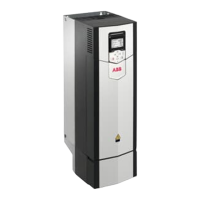Note: In scalar motor control mode, the output voltage can alternatively be
increased by adjusting the
U
/
f
curve: by setting parameter 97.7. The value of 97.7,
can be calculated as the ratio of the desired voltage and the nominal voltage. In
this example, the ratio is 440 V / 400 V = 110%. Set the value of 97.7 to 110% and
leave motor nominal voltage as 400 V.
Limits
There are two types of limitations that you must take into account when you use
the DC voltage boost function: limitations to the DC voltage reference and the
limitation to the drive output voltage.
The drive calculates the minimum and maximum limits for the User DC voltage
reference (94.22). The calculation is based on the actual supply voltage and the
upper limit of the largest supply voltage range selection available for the drive
(95.1). Limits are:
1. Minimum limit: Internal DC voltage reference (
U
dc,int
).
2. Maximum limit: Maximum DC voltage reference (
U
dc,max
).
For more information, see the table below and sections Internal DC voltage
reference (
U
dc,int
) and Maximum DC voltage reference (
U
dc,max
).
This table summarizes the limits to the user-defined DC voltage reference and to
the drive output voltage.
Maximum drive
output voltage
with parameter
97.4 default value
Maximum DC
voltage reference
(
U
dc,max
)
Internal DC voltage
reference (
U
dc,int
)
1)
95.1 selectionDrive
type
479 V663 V553 V380…415 VxxxA-3
576 V799 V553 V380…415 VxxxA-5
641 V440…480 V
728 V500 V
795 V1102 V764 V525…600 VxxxA-7
981 V660…690 V
1)
See section Internal DC voltage reference (
U
dc,int
).
Internal DC voltage reference (
U
dc,int
)
U
dc,int
=
U
ac,rms
× √2 × 1.03
where
Internal DC voltage reference
U
dc,int
108 Program features

